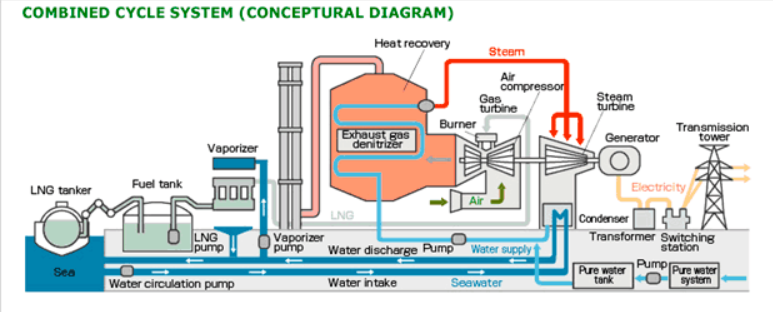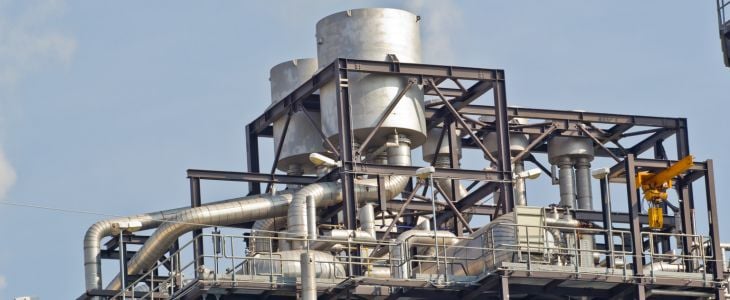The combined cycle gas turbine has gained recent popularity as a reliable, efficient, and environmentally-friendly solution for electricity generation.
As more and more operators look for alternatives to transition to cleaner energy sources, options like the combined cycle power plant are regarded as a choice that also guarantees grid stability and reliability.
However, while a combined cycle gas turbine can present multiple advantages, there are some drawbacks for certain types of project which may make operators consider other efficient alternatives. Let’s take a look.
What is a combined cycle gas turbine
A combined cycle gas turbine (CCGT) is a type of power generation system that combines two different thermodynamic cycles to produce electricity while pushing efficiency.
As such, the combined cycle gas turbine model involves the integration of a gas turbine cycle and a steam turbine cycle, which work together to extract energy from a fuel source, typically natural gas. This involves putting to work two principles: the Brayton cycle (the one used by conventional gas turbines), and the Rankine cycle (used by a steam turbine).
How does a combined cycle gas turbine work
The process begins with a gas turbine. Natural gas is burned in the combustion chamber of the gas turbine, producing a high-velocity stream of hot gasses. Their expansion through a series of turbine blades causes the turbine to spin, a rotation that drives a generator that produces electricity.
Next comes a stage for waste heat recovery. In this phase, exhaust gasses leaving the gas turbine are still quite hot so, instead of letting this heat go to waste, it is utilized in the combined cycle system.
In order to do so, the hot gasses pass through a heat recovery steam generator (HRSG), which contains a series of heat exchangers, able to transfer the heat from the exhaust gasses to water and thus creating steam.
Thanks to this operation, the steam turbine cycle can start. At this stage, the steam generated in the HRSG is used to drive a steam turbine, which in turn drives another generator to produce additional electricity.
All in all, by combining the gas turbine cycle and the steam turbine cycle, the CCGT system effectively manages to use the high-temperature exhaust gasses from the gas turbine to generate steam and produce even more electricity.
This results in a higher overall efficiency of combined cycle power plants compared to standalone gas or steam turbine power plants, and is what has made the combined cycle gas turbine and the combined cycle power plant so widespread today.

Advantages and disadvantages of the combined cycle gas turbine
Advantages
Higher Efficiency
The combined cycle gas turbine is known for its high thermal efficiency. As we’ve explained above, by combining the gas turbine cycle and the steam turbine cycle, this system can utilize a larger portion of the energy contained in the fuel, resulting in higher electricity generation efficiency compared to traditional gas or steam turbine power plants. In fact, the energy conversion efficiency of combined cycle power plants is around 55-60% (compared to 35-45% for conventional thermal power plants).
Flexibility
A combined cycle gas turbine operates efficiently at partial load and guarantees stability in an era in which the growth of renewable energy electricity generation is increasing but remains intermittent.
Low emissions
The combustion of natural gas in the gas turbine produces fewer emissions of pollutants and greenhouse gasses, such as sulfur dioxide (SO2), nitrogen oxides (NOx), and carbon dioxide (CO2), compared to coal-fired power plants.
Fast Start-Up and Load Response
Combined cycle power plant projects can start up quickly and respond rapidly to changes in electricity demand. This flexibility makes them well-suited for providing peak-load power.
Additionally, CCGT plants can operate as both base load and peak load power sources. This means that they can run continuously to provide a stable baseline of power, and their ability to ramp up quickly makes them valuable for meeting sudden spikes in demand.
Disadvantages
External power is needed
The combined cycle power plant is in need of external energy to start the compressor. In order to do so, natural gas and biogas remain the most common source of energy.
This may also raise environmental concerns because, while CCGT plants emit fewer pollutants and greenhouse gasses compared to coal-fired plants, they still produce carbon dioxide (CO2) emissions. As concerns about climate change grow, there is increasing pressure to transition to even cleaner energy sources with minimal to no CO2 emissions, including industrial heat pumps.

High temperatures mean high maintenance needs
The high temperatures that are generated in a combined cycle power plant mean that great care must be taken both in the design phase as well as during maintenance operations. The combustion chamber can reach about 1700 °C, temperatures that might translate into reduced life cycles for materials and components within the system.
This means an efficient combined cycle gas turbine needs to incorporate a cooling scheme or method, which will also guarantee greater efficiencies. This is where TIAC technologies come in.
As we’ve mentioned above, performance of combined cycle models can be reduced when ambient temperatures are high. For instance, a gas turbine operating at 0 ºC ambient temperature values can produce about 15% more electricity than the same turbine at 30 ºC ambient temperature values.
This reduction is critical, as electrical peak demand periods usually take place at the same time as high ambient temperature periods (take cooling demand as an example).
Through TIAC (Turbine Inlet Air Cooling), it’s possible to improve gas turbine performance by employing technology to decrease inlet air temperature. This effectively acts as a counterbalance to the main disadvantage of the combined cycle gas turbine.
The result is a cooling down of the intake air of the Gas Turbine (GT) and, ultimately, the achievement of power output augmentation. These technologies ensure the combined cycle gas turbine has a constant inlet air temperature, which translates in increasing the power output and maintaining it stable against temperature changes.
As such, it is able to generate direct economic advantages:
- It increases the annual average output MW of the equipment
- It saves capital costs in comparison to additional turbine installation needed to respond to energy demands
TIAC technologies are increasingly adopted in hot climates, where high ambient temperatures that usually coincide with on-peak power demand must be dealt with. As the worldwide energy demand continues increasing, energy efficiency remains a key goal to be obtained, and TIAC offers just that in the context of the combined cycle gas turbine.
At ARANER, we work to develop state-of-the-art Turbine Inlet Air Cooling solutions to help operators push their equipment’s efficiency and life cycle further by improving the thermal stresses and avoiding the thermomechanical fatigue typically associated with cyclic models.
Our solutions are suitable for already existing gas turbine systems (as well as new projects) and are able to improve power output with no need to increase the size of the power plant.
Want to learn more? Get in touch with us and discover cutting-edge TIAC technologies ready to boost efficiency in any combined cycle gas turbine.










